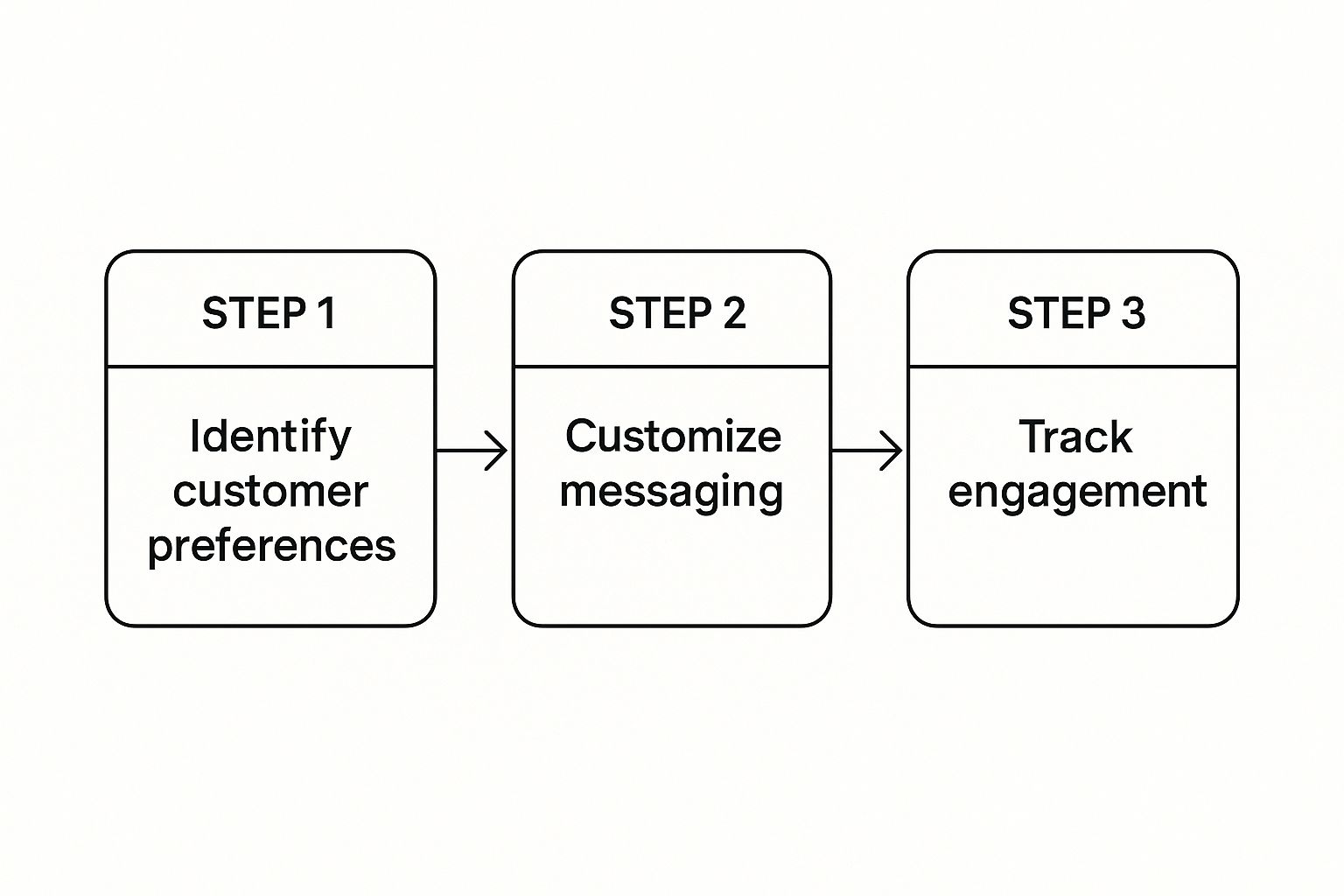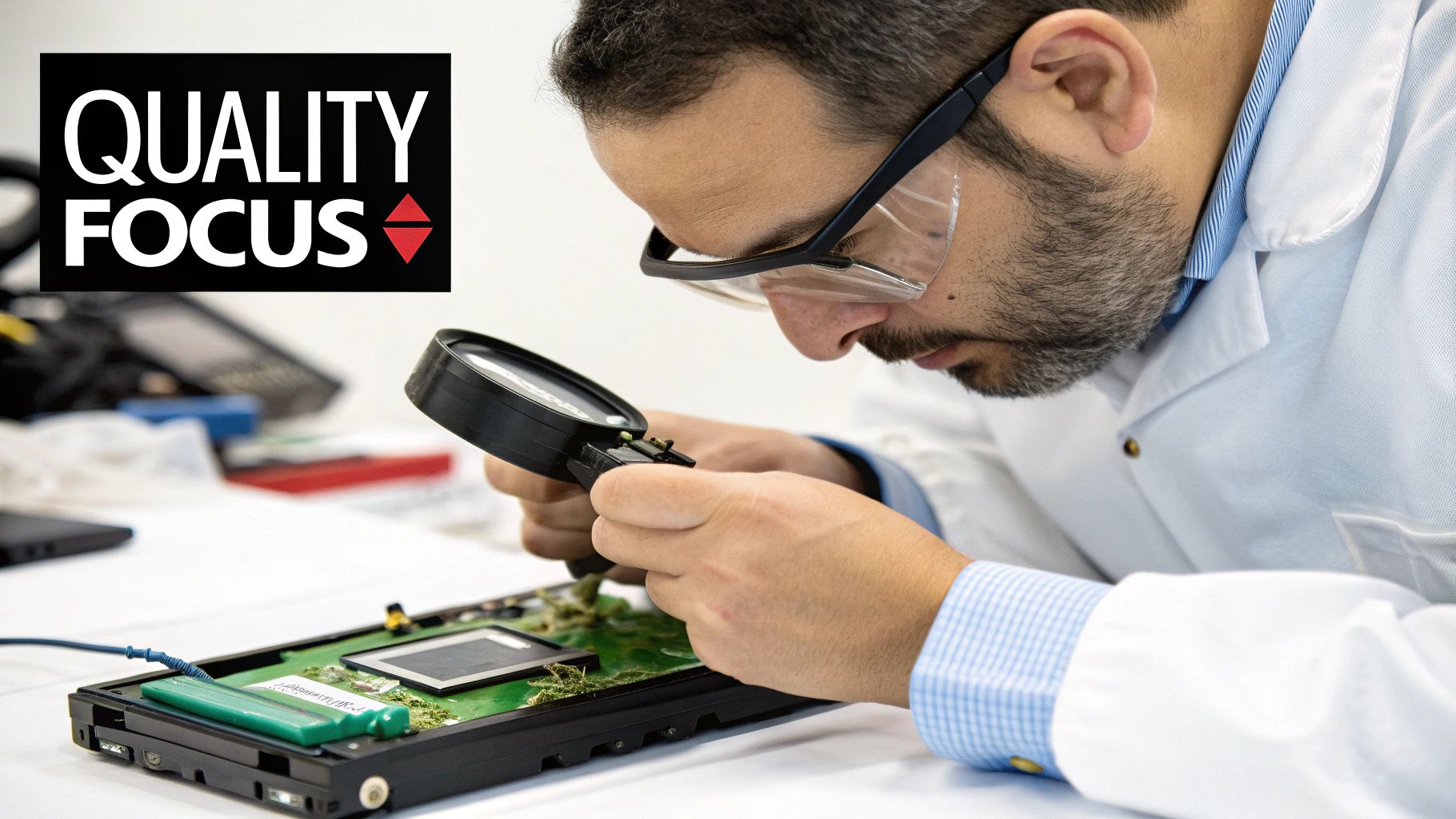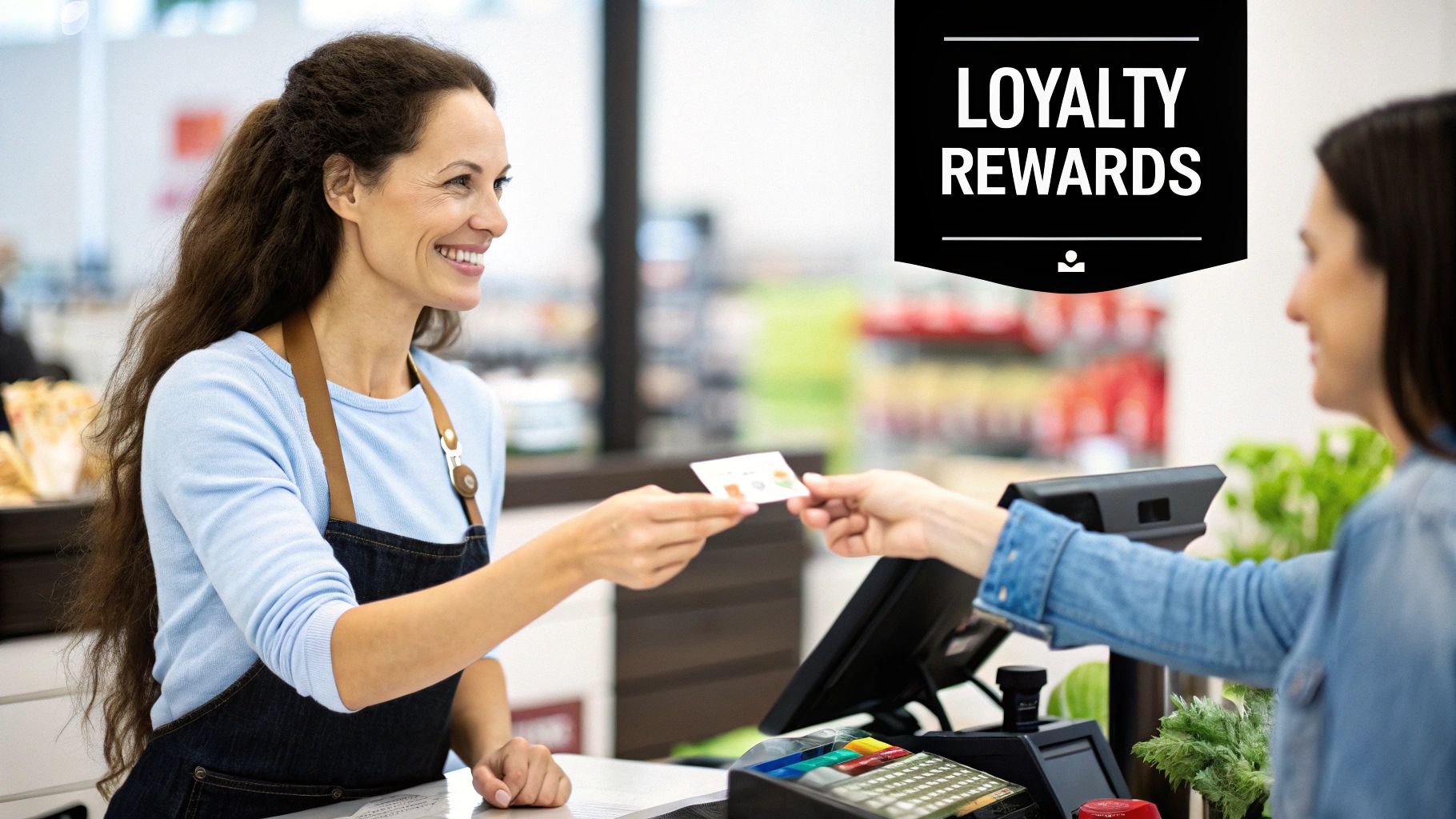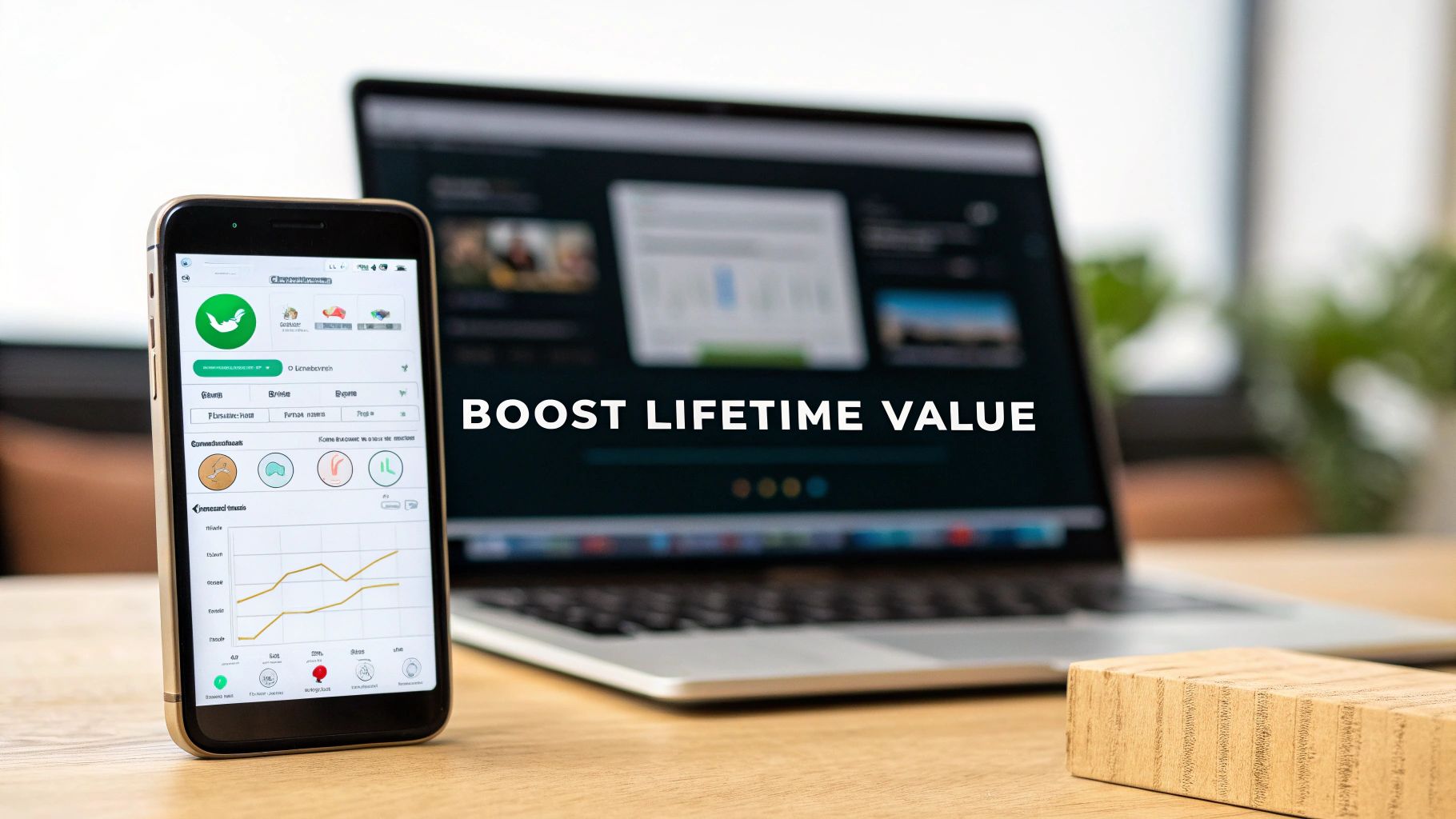If you feel like you're stuck on a customer acquisition treadmill, you're not alone. Many Shopify store owners pour their budgets into ads, get that initial sale, and then… nothing. The customer vanishes. We call this the "leaky bucket" problem, and from our experience with over 500 Shopify stores, it's the biggest barrier to sustainable growth.
Businesses get hooked on the thrill of landing new customers, obsessing over their Cost Per Acquisition (CPA). All the while, they're sitting on a goldmine they completely ignore: the people who have already bought from them. In this playbook, you'll learn exactly how to stop the leak and how to increase customer lifetime value using the one channel your customers actually pay attention to.
The High Price of Neglecting Your Existing Customers
Relying solely on acquiring new customers is an exhausting and expensive game. The simple truth is that your most valuable, most profitable customers are the ones who already know and trust your brand.
This isn't just a gut feeling; the data is crystal clear. E-commerce studies consistently show that returning customers spend, on average, 67% more than brand-new ones. That single statistic should be a wake-up call. Shifting your focus isn't just a good idea—it's absolutely critical for building a business that lasts. You can dive deeper into these customer lifetime value findings yourself.
This really boils down to two core metrics you need to live and breathe:
- Customer Lifetime Value (LTV): The total amount of money a customer is likely to spend with you over their entire relationship with your brand. A higher LTV means more predictable revenue.
- Customer Acquisition Cost (CAC): What it costs you, on average, to get a single new customer in the door.
A healthy, growing store doesn't just watch these numbers; it masters the relationship between them.
The benchmark we always give our clients is to aim for an LTV to CAC ratio of at least 3:1. For every dollar you spend getting a customer, they should bring in at least three dollars in revenue. If your ratio is dipping below that, your business's growth engine is probably running on fumes.
The Perfect Channel for Building Lasting Relationships
So, what's the secret to closing that gap and turning one-time buyers into loyal advocates? You have to meet them on a channel designed for genuine, two-way conversation. Email is overflowing, and social media is a shouting match. The real opportunity is on the app your customers already use every single day: WhatsApp.
Think about it. With a staggering 98% open rate, WhatsApp messages don't just land in an inbox; they land directly in your customer's pocket. It bypasses all the noise.
This makes it the ideal place to have the kind of personal, timely conversations that build real loyalty. As an official Meta Business Partner, we've seen Kanal completely change the game for Shopify stores by turning WhatsApp into a powerhouse for boosting customer lifetime value. Let’s walk through exactly how you can do it, too.
How to Identify Your High-Value Customer Segments

Before you can increase customer lifetime value, you first need to know who you’re talking to. Sending the same generic message to every customer is a surefire way to get ignored. A common mistake we see is brands blasting everyone with the same offer and then wondering why their engagement numbers are flat.
Here’s the thing: not all customers are the same. This isn't about playing favorites; it's about acknowledging that different groups have different needs and bring different value to your business. We often see the Pareto Principle play out in real-time, where a small slice of customers drives a massive chunk of your revenue. It's not uncommon for the top 20% of customers to generate 80% of sales, which is a huge opportunity for brands that can pinpoint and cultivate these key relationships.
Moving Beyond Basic Demographics
To truly get a handle on your best customers, you have to dig deeper than surface-level data like age or location. The real insights are hidden in their behavioral data—how they actually interact with your Shopify store. This is what signals who has high LTV potential.
When we're working with clients, we get them to zero in on a few core behavioral metrics:
- Purchase Frequency: How often do they buy? A customer who has purchased three times is infinitely more valuable than a one-and-done buyer.
- Average Order Value (AOV): What's their typical spend per order? Customers with a high AOV are your best bet for upselling premium products.
- Product Preferences: What collections are they shopping from? Someone who buys from multiple categories is clearly more invested in your brand.
All this information is sitting right there in your Shopify analytics. These data points are the building blocks for creating customer segments that you can actually do something with, making your strategy to increase customer lifetime value far more effective.
Creating Actionable Segments in Kanal
Once you've spotted these behavioral patterns in your Shopify data, the next step is to build hyper-targeted segments directly within Kanal. This is where the magic happens, allowing you to tailor your WhatsApp communication with incredible precision so that every message hits the mark.
For example, look how easy it is to create a powerful, high-LTV segment right inside the platform:

This screenshot shows you can combine Shopify data points like "Total Spent" and "Number of Orders" to isolate your best customers. With this segment, you could send an exclusive offer or an early access announcement directly to their WhatsApp—a personal touch they'll appreciate.
Here are a few of the most effective segments we've seen our clients use to drive repeat purchases:
- VIP Spenders: Customers in the top 10% based on total spend.
- Frequent Buyers: Anyone who has made 3 or more purchases.
- Brand Loyalists: Shoppers who have bought from 2 or more different product collections.
- Potential Churn: A segment of customers who haven't purchased in the last 90 days but used to be regulars.
Getting these segments right is the foundational step. It shifts your marketing from a shotgun blast to a series of smart, impactful conversations. For a deeper look at what to track, explore our guide on the key customer engagement metrics that truly signal customer loyalty.
Automated WhatsApp Flows That Drive Repeat Sales
Once you’ve identified your most valuable customers, the real work begins. This is where you turn insights into revenue. After working with over 500 Shopify stores, I can tell you that the single most effective way to boost LTV is by setting up automated, personal WhatsApp conversations that trigger at just the right moment.
This isn't about spamming your customers with generic deals. It's about being genuinely helpful and timely. The strategy that gets the best results, time and time again, is creating flows that feel less like marketing and more like a personal concierge service. When you get this right, you stop being just another store and become a trusted advisor.
The Post-Purchase Nurture Flow
The window right after a customer buys something is golden. It's your single biggest chance to secure their next purchase. They're excited, their order is on the way, and your brand is fresh in their mind. Sending a basic transactional email here is a massive missed opportunity.
Instead, a post-purchase WhatsApp flow can build on that initial excitement and start a real conversation. We’ve seen clients using Kanal boost their repeat purchase rate by as much as 22% just by implementing a thoughtful post-purchase sequence.
Here’s a simple but powerful way to structure it:
- Example: “Hey [FirstName]! It’s [Your Name] from [Brand Name]. Just checking in to see how you’re loving your new [ProductName]. Let me know if you have any questions!”
- Example: “Since you loved the [ProductName], we thought you might like our [RelatedProduct]. Here’s a 15% off code just for you: VIP15.”
This approach turns a simple transaction into the beginning of a long-term relationship. It's a cornerstone of how to increase customer lifetime value effectively.
The Automated Replenishment Reminder
If you sell consumable products—think coffee, skincare, or supplements—this flow is an absolute goldmine. It creates predictable, recurring revenue by reminding customers to re-order right before they run out. You aren't just hoping they remember your brand; you're making sure of it.
A classic mistake is sending these reminders on a generic schedule. The real magic happens when you use purchase data to personalize the timing.
- Did a customer buy a 30-day supply of vitamins? You should send the reminder on day 25.
- Did another grab a 60-day supply? Their reminder should go out on day 55.
This simple logic—identifying preferences, customizing the message, and tracking what works—is the key to making these campaigns successful.

The image above really drives home a core principle we live by at Kanal: personalized communication at scale isn't just a fantasy. It's essential for building a loyal customer base.
Pro Tip: Make reordering ridiculously easy. In your WhatsApp reminder, include a direct link to a pre-filled cart. The fewer clicks, the better. We've seen this one tweak alone boost re-order rates by an extra 10-15% for our clients. It's a no-brainer.
The Smart Cross-Sell and Upsell Flow
This is where all that hard work you did with customer segmentation really starts to pay off. By looking at past purchase data, you can send hyper-relevant product recommendations that your customers actually want and need. It’s the digital version of a great retail employee who knows a customer's taste inside and out.
Here's a real-world example from a beauty brand we work with:
- Scenario: A customer buys their best-selling Vitamin C serum.
- Trigger: The flow kicks in 10 days after the purchase.
- WhatsApp Flow: “Hey [FirstName]! Hope you’re enjoying the glow from our Vitamin C serum. ✨ Many of our customers find it works even better when paired with our Hyaluronic Acid Moisturizer. Want to complete your routine? Here’s a link to check it out.”
See how that feels helpful, not salesy? You're using data to make a smart, relevant suggestion.
These automated flows are the engine of modern customer retention. Setting them up in an app like Kanal creates a system that works around the clock to increase customer lifetime value, turning one-time buyers into lifelong fans.
To help you get started, here's a quick look at some high-impact flows you can implement right away.
High-Impact WhatsApp Automation Flows
This table breaks down some of the most essential automated campaigns for any Shopify store, along with their goals and the metrics that matter most.
Think of these flows as your core playbook. Master them, and you'll have a powerful system for consistently driving growth and building a brand that customers truly love.
Nurturing Your VIPs for Maximum Lifetime Value

Automated flows are fantastic for keeping the sales engine running, but they have their limits. If you want to squeeze every last drop of value from your top spenders, you need to think beyond automation and start building a real community. It’s time to roll out the red carpet and make your most valuable customers feel like insiders.
The strategy that consistently delivers the best results for our clients is launching a dedicated "VIP Club" on WhatsApp. This isn't just another marketing channel; it's an exclusive space where your best customers get perks nobody else can touch.
You're essentially creating an inner circle for your brand, transforming top buyers into passionate advocates. The goal is to build a relationship so strong that they wouldn't even think about shopping anywhere else.
Launching Your Exclusive WhatsApp VIP Club
Setting up a VIP Club is probably easier than you think. Using the customer segments you've already created in Kanal—like your "VIP Spenders" or "Brand Loyalists"—you can create a hand-picked list for this exclusive group. This is where you swap out broad automation for highly personal, high-value conversations.
Once you have your segment, what kind of perks can you offer? Here are a few high-impact ideas we've seen work incredibly well:
- Early Product Access: Give your VIPs a 24-hour head start before a new collection goes live. The scarcity and exclusivity make them feel special and drive immediate sales.
- VIP-Only Discounts: Offer a standing discount, like "VIPs always get 15% off," or send unique codes that aren't available to the public.
- A Direct Line to Support: Let your VIPs skip the queue. If they have a question, they can message you directly on WhatsApp for a fast, personal response.
Fostering a True Community
Here's where the real magic happens. A VIP Club isn't just about the perks; it’s about the connection. This is your chance to build a genuine community, not just another customer list. A lot of the same ideas found in lead nurturing best practices apply here, because it's all about building for the long term.
A common mistake we see is brands treating their VIPs just like any other customer segment, but with slightly better offers. That’s not enough. You need to completely change the nature of the conversation.
Expert Takeaway: Your goal is to make these customers feel like they are part of your brand's journey. Their LTV isn't just measured in their own purchases, but in the powerful referrals and social proof they generate for you. They become a natural extension of your marketing team.
So, instead of just broadcasting offers, start real conversations.
- Ask for Direct Feedback: "Hey VIPs, we're developing a new product and would love your input. What do you think of this design?"
- Send Personalized Videos: Use a quick video to send a personal thank-you to your top 10 spenders each month. The impact of this simple gesture is enormous.
- Share Behind-the-Scenes Content: Give them a sneak peek of a new photoshoot or a look inside your workshop. Make them feel like they're on the inside.
This level of engagement has a massive impact. We know that a highly engaged customer base can lead to a CLV increase of 300% to 500% compared to less engaged shoppers. Repeat customers don't just keep buying; they spend up to 67% more because that trust is already there.
Building this community is one of the most powerful things you can do for your brand. For even more inspiration, check out our guide on customer loyalty program ideas.
Measuring What Matters: LTV Metrics You Can Actually Use
You can’t improve what you don’t measure. It’s a simple truth, but it’s the bedrock of any successful strategy to increase customer lifetime value. Too many brands get hyper-focused on campaign-level ROI and completely miss the bigger picture. Are your marketing efforts actually making customers more valuable over the long haul?
From our experience with over 500 Shopify stores, we’ve seen a common pitfall firsthand. Brands will track LTV as a single, big-picture number, but they fail to monitor the underlying metrics that actually drive that number. To get a real-time pulse on your customer health, you have to look beyond the basic LTV formula and dig into more actionable KPIs.
The trick is to build a simple, powerful dashboard using your Shopify analytics and Kanal's reporting. This setup will show you what’s really moving the needle.
Going Beyond the Basic Formula
The standard LTV calculation is a solid starting point, but it's a lagging indicator. It tells you what already happened, not what’s happening right now. To make smart, proactive decisions that boost revenue, you need to track the metrics that predict future LTV.
We have a whole guide on how to calculate customer lifetime value that walks through the fundamentals. But for this guide, let’s zero in on the KPIs that give you an immediate, actionable snapshot of your business.
Based on our experience, these are the three metrics that matter most:
- Repeat Purchase Rate: What percentage of your customers have come back for a second, third, or fourth purchase? This is probably the single best indicator of genuine customer loyalty and the overall health of your retention strategy.
- Average Time Between Purchases: How long does it usually take for a customer to buy from you again? Shrinking this window is one of the most direct ways to increase LTV.
- Customer Cohort Value: This involves grouping customers by the month they made their first purchase (e.g., the "January Cohort") and tracking their total spending over time. It’s the perfect way to see if the new customers you’re acquiring today are becoming more valuable than the ones you acquired six months ago.
Proving the Value of Conversational Marketing
Now for the most important part of measurement: proving that your efforts are having a direct impact. It’s not enough to just feel like your WhatsApp campaigns are working. You need cold, hard data to show exactly how much they contribute to long-term profitability. This is how you justify your investment and get buy-in for future initiatives.
The strategy that consistently delivers the clearest results for our clients is comparing the LTV of customers who engage on WhatsApp versus those who don't. This isn't just a theory; it's a measurable reality you can track.
Inside your Shopify analytics, you should set up two distinct customer segments:
- Segment A: Customers who opted into and interacted with your WhatsApp channel (you can track this using tags from Kanal's integration).
- Segment B: All other customers who haven't engaged on WhatsApp.
Once you have these segments, track the LTV for both groups over 3, 6, and 12 months. Time and time again, we see the LTV of the WhatsApp-engaged cohort climb significantly higher—often by 25-40%. We've seen clients increase their LTV by over 30% using exactly this methodology.
This is no accident. It’s the direct result of building real relationships through timely, personal, and helpful conversations. When you can walk into a meeting and present this data, you're no longer just running campaigns; you’re building a proven engine for sustainable growth.
Your Action Plan for Increasing Customer LTV

Alright, we’ve covered a lot of ground on the "why" and "how" of boosting LTV. Now it's time to roll up your sleeves and get to work. The biggest mistake we see brands make is treating LTV like a project they can check off a list. It’s not. Learning how to increase customer lifetime value is a daily discipline, not a one-and-done campaign.
This final section is your playbook. It cuts through the noise and gives you a clear, no-fluff plan for building stronger customer relationships—and a much healthier bottom line.
Your Immediate Implementation Checklist
Don't try to boil the ocean. Getting started is often the hardest part, so let's break it down into manageable first steps. Nail one, then move on to the next.
Define Your Core Segments: First things first, who are your best customers? Log into Shopify and pull two simple lists: your 'VIP Spenders' (the top 10% by total spend) and your 'Frequent Buyers' (anyone with 3+ purchases). Don't overthink it. These two groups are your gold mine.
Launch Your Post-Purchase Flow: This is the lowest-hanging fruit, period. Inside Kanal, set up a basic two-message WhatsApp flow. The first message goes out 7 days after delivery to check in and see how they're enjoying their purchase. The second goes out on day 21 with a smart, relevant cross-sell. This one flow can start moving the needle on your repeat purchase rate almost immediately.
Start Your VIP Nurturing: Take that 'VIP Spender' segment you just created. This month, send them a single, non-promotional message. It could be a simple ask for feedback on a new product idea or an offer for early access to a sale before anyone else. The goal is simple: make them feel special.
Track the Right Numbers: Forget complicated spreadsheets for now. Focus on one metric that truly matters: Repeat Purchase Rate. Is it ticking up month over month? To get your starting point, plug your numbers into a good customer lifetime value calculator. This gives you a clear baseline to measure against.
Reinforce Your Long-Term Strategy
Building real, sustainable LTV is a marathon, not a sprint. The tactics above get you out of the starting blocks, but long-term success requires a shift in your thinking.
After working with over 500 Shopify stores, I can tell you this: the brands that win are the ones who become obsessed with the post-purchase experience. They get that the first sale isn't the finish line; it's the start of the relationship.
Every WhatsApp message you send is a chance to deliver value, build trust, and remind your customer they're more than just an order number. While our focus here is on e-commerce, the core ideas about retention are universal. In fact, there are some great parallel insights in this piece on Boosting SaaS Customer Lifetime Value that reinforce these foundational principles.
By consistently following this playbook, you're doing more than just sending messages. You're building a resilient brand powered by customers who don't just buy from you, but believe in you.
Got Questions? We’ve Got Answers
When we talk with e-commerce brands about diving into WhatsApp marketing, the same few questions always pop up. It's a newer channel for many, so that's completely normal. Let's walk through the common concerns we hear every day, so you can get started with total confidence.
What’s This Actually Going to Cost Me?
This is usually the first thing people ask, and for good reason. You need to know the numbers. The official WhatsApp Business Platform uses a conversation-based pricing model, which is a bit different from what you might be used to.
Essentially, Meta charges you per 24-hour conversation window with a customer, not per individual message. That window kicks off the moment you send your first message. All the back-and-forth within that 24-hour period is included in a single conversation fee.
The exact rate changes slightly from country to country, but here's the mindset shift we encourage: don't see this as just another marketing cost. See it as a direct investment in your store's LTV. To make this easier, our Kanal app has a built-in cost estimator. You'll see the exact cost of a campaign before hitting send. That kind of transparency, paired with the massive ROI we see from WhatsApp, makes it one of the smartest ways to increase customer lifetime value.
Will I Just End Up Annoying My Customers?
We hear this a lot, and frankly, it’s a great concern to have. It shows you care about the customer experience. The fear of being spammy is valid, but WhatsApp has a powerful, built-in defense against that: explicit consent.
A customer has to ask to hear from you by opting in. They've already raised their hand and said, "Yes, talk to me here." This is a world away from a cold email or a random SMS blast.
Key Takeaway: The secret to keeping customers happy on WhatsApp isn't about messaging less; it's about messaging smarter.
The strategy that works time and time again for the brands we work with is to be relentlessly helpful and relevant.
- Set expectations upfront. Tell them what kind of messages they'll get and roughly how often. No surprises.
- Segment like a pro. Use your Shopify data to make sure every single message feels like it was written just for them.
- Deliver real value. Think exclusive access, helpful tips related to their purchase, or proactive support—not just another 10% off coupon.
Do this right, and customers won't just tolerate your messages; they'll look forward to them.
How Fast Will I Actually See My LTV Go Up?
Let's set some real-world expectations here. You'll see immediate results in certain areas. An abandoned cart recovery flow, for example, can start winning back sales within hours of going live. We’ve watched clients boost their repeat purchase rate with a post-purchase automation in the very first month.
But a major, measurable lift in your store-wide LTV? That’s more of a marathon than a sprint. It’s the result of consistently building stronger relationships over time. Quick wins are great, but the real magic happens as these automated flows and VIP conversations compound.
Based on what we've seen across hundreds of stores, most brands see a truly meaningful increase in their cohort LTV over a 3-6 month period.
Ready to put these ideas to work and start building your own high-ROI WhatsApp strategy? Install Kanal on your Shopify store today, or book a personalized demo with our team to see exactly how you can start growing your LTV.



